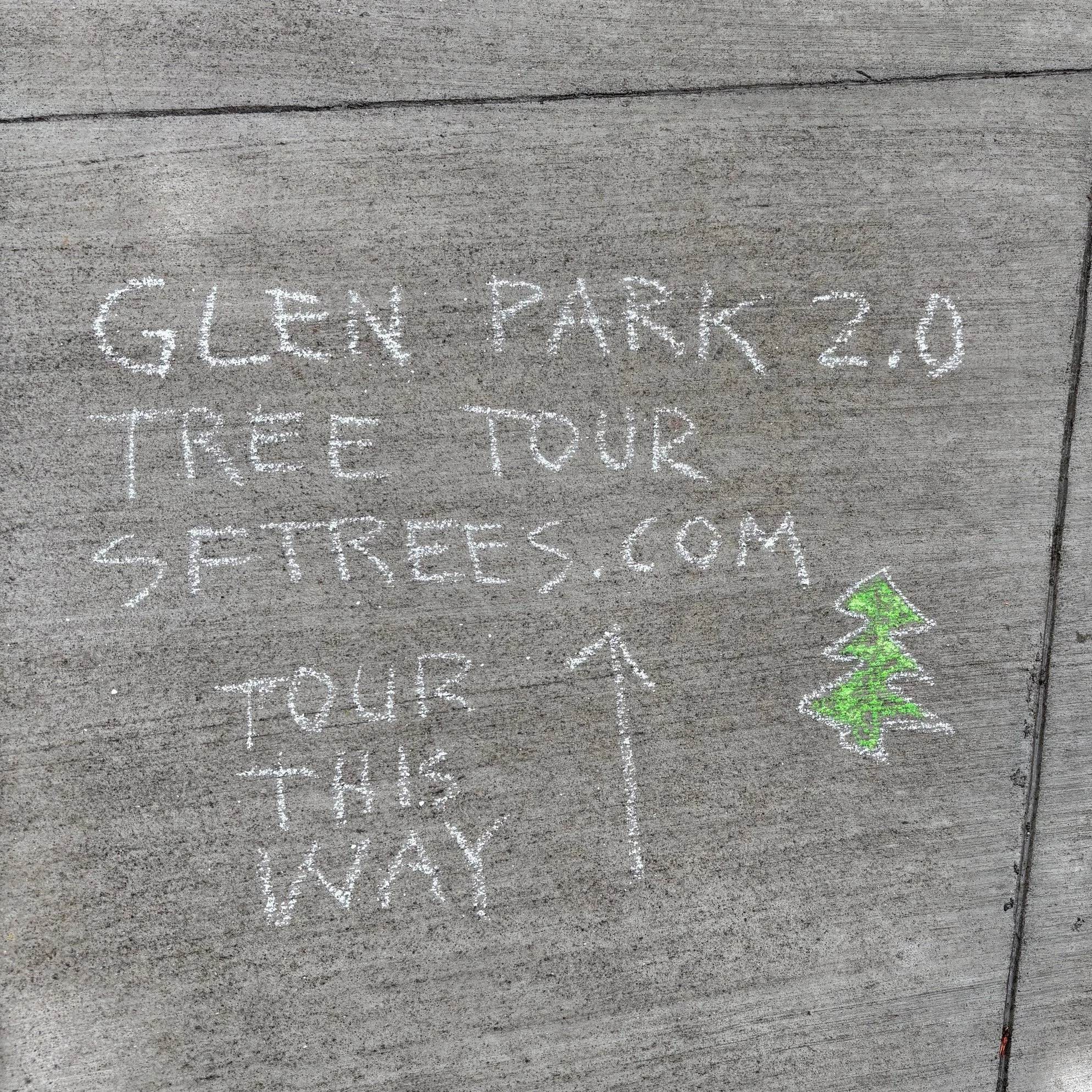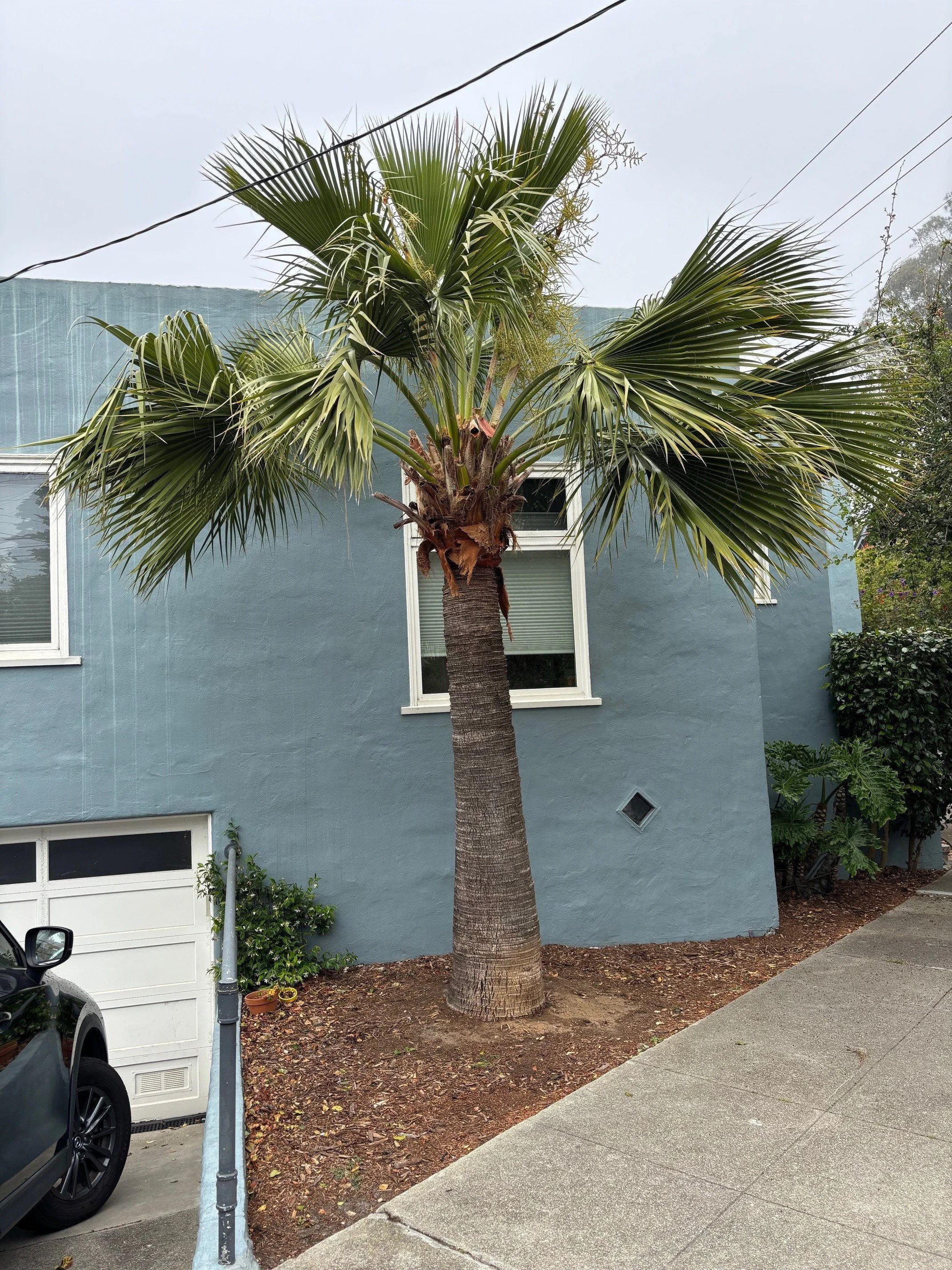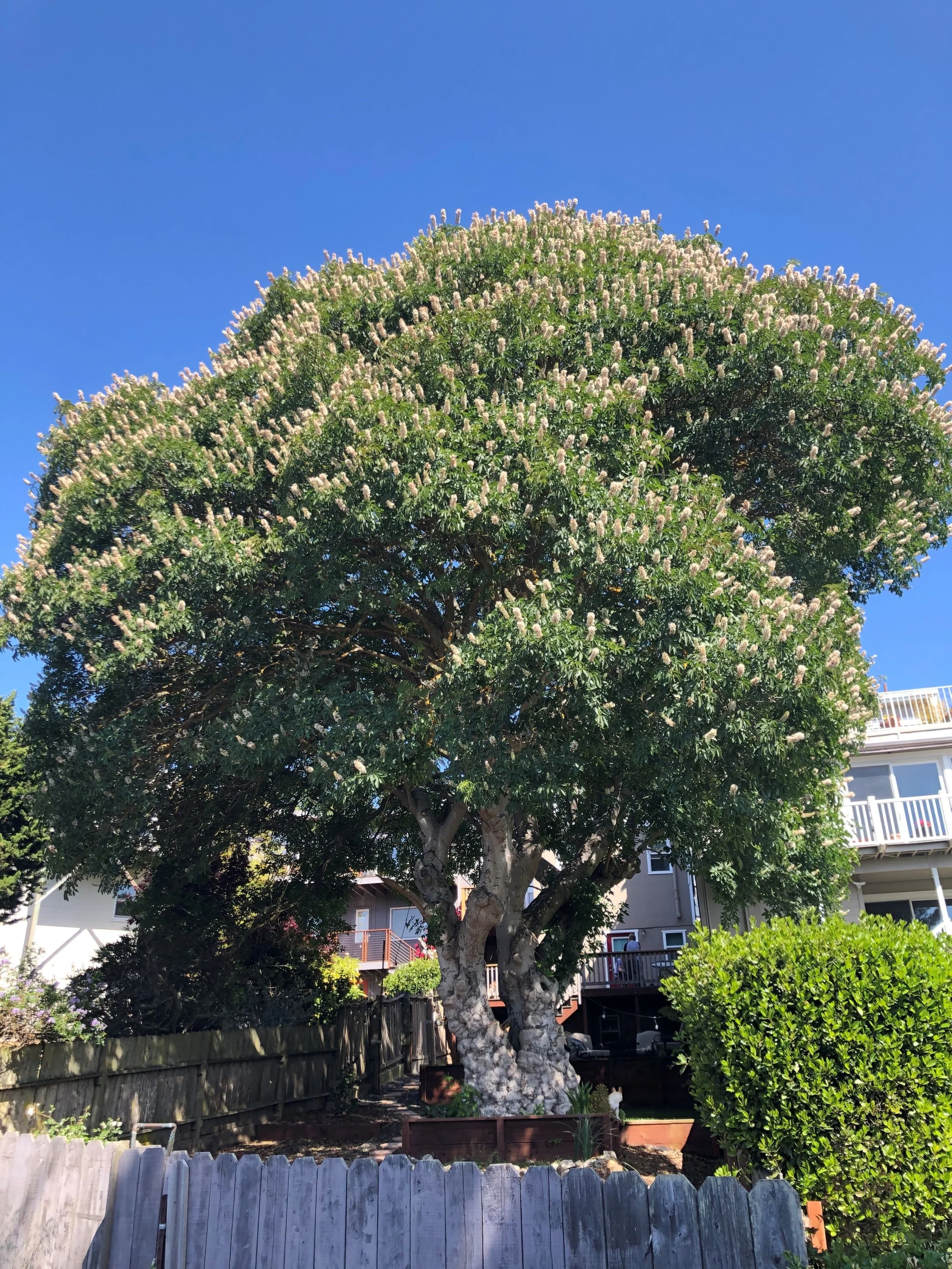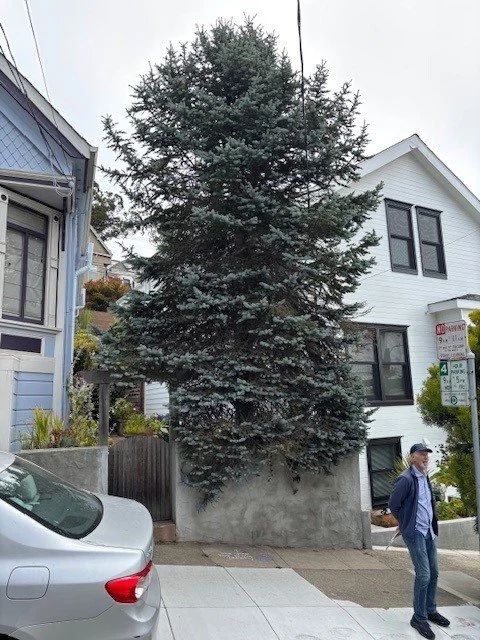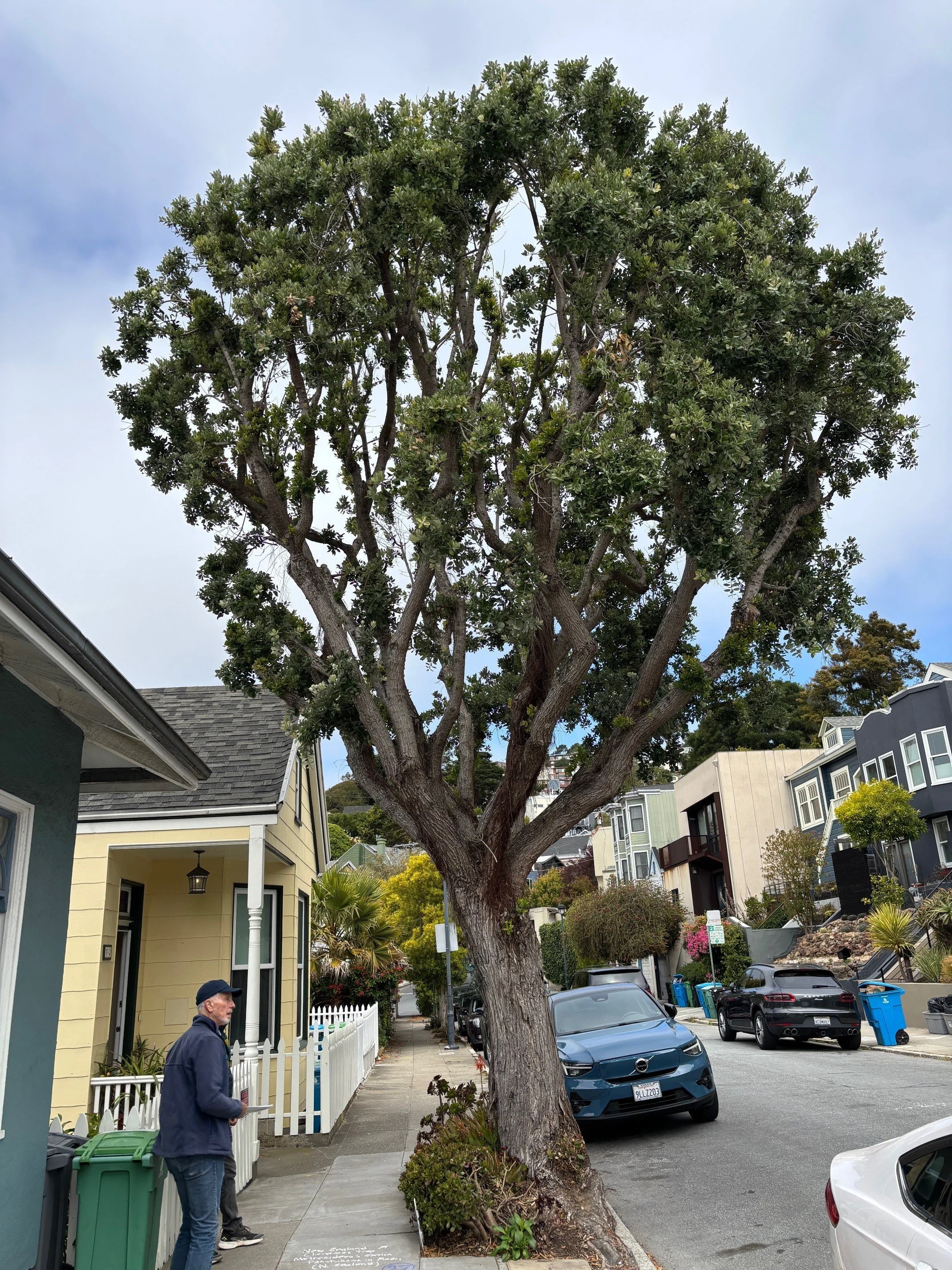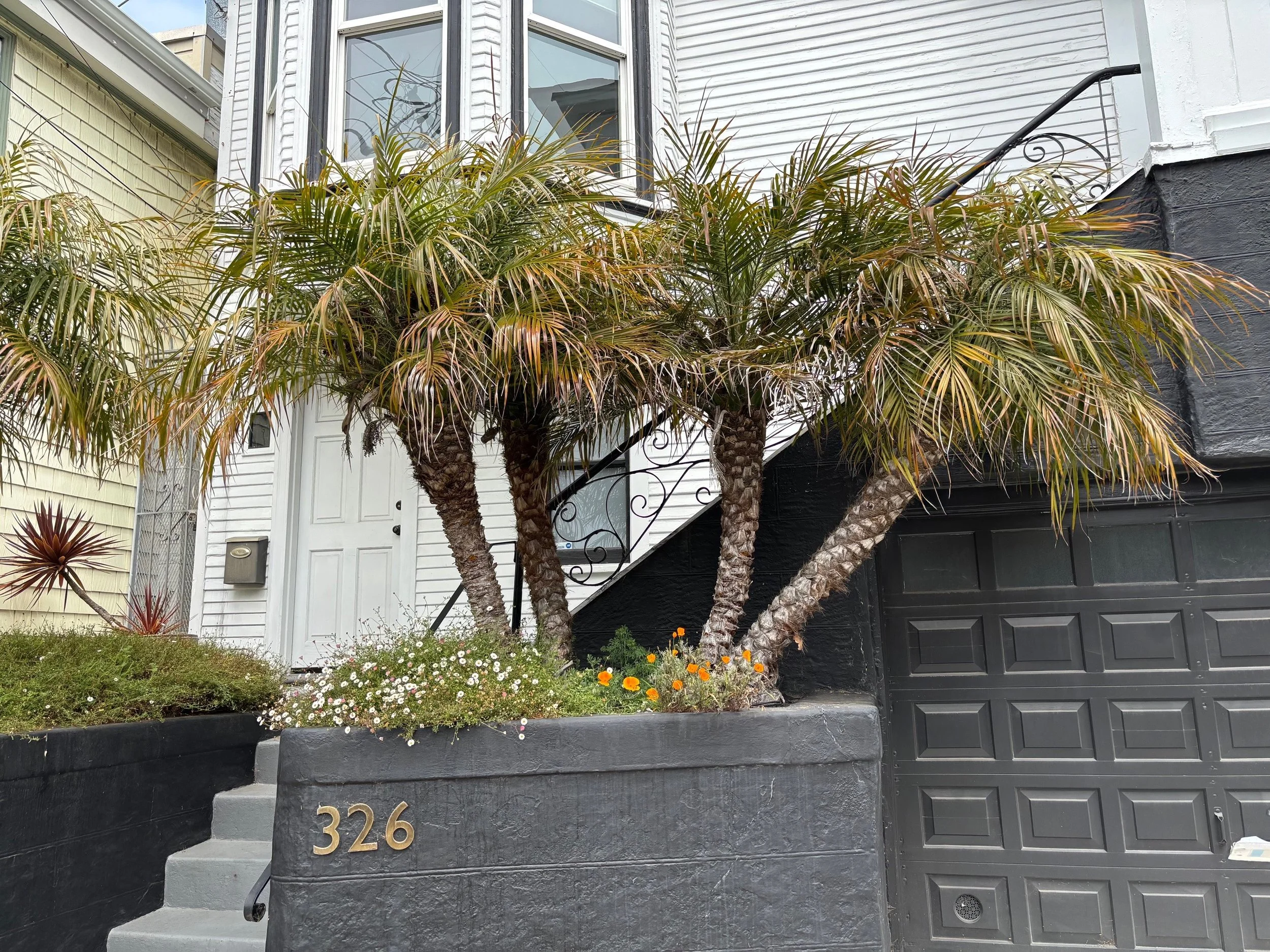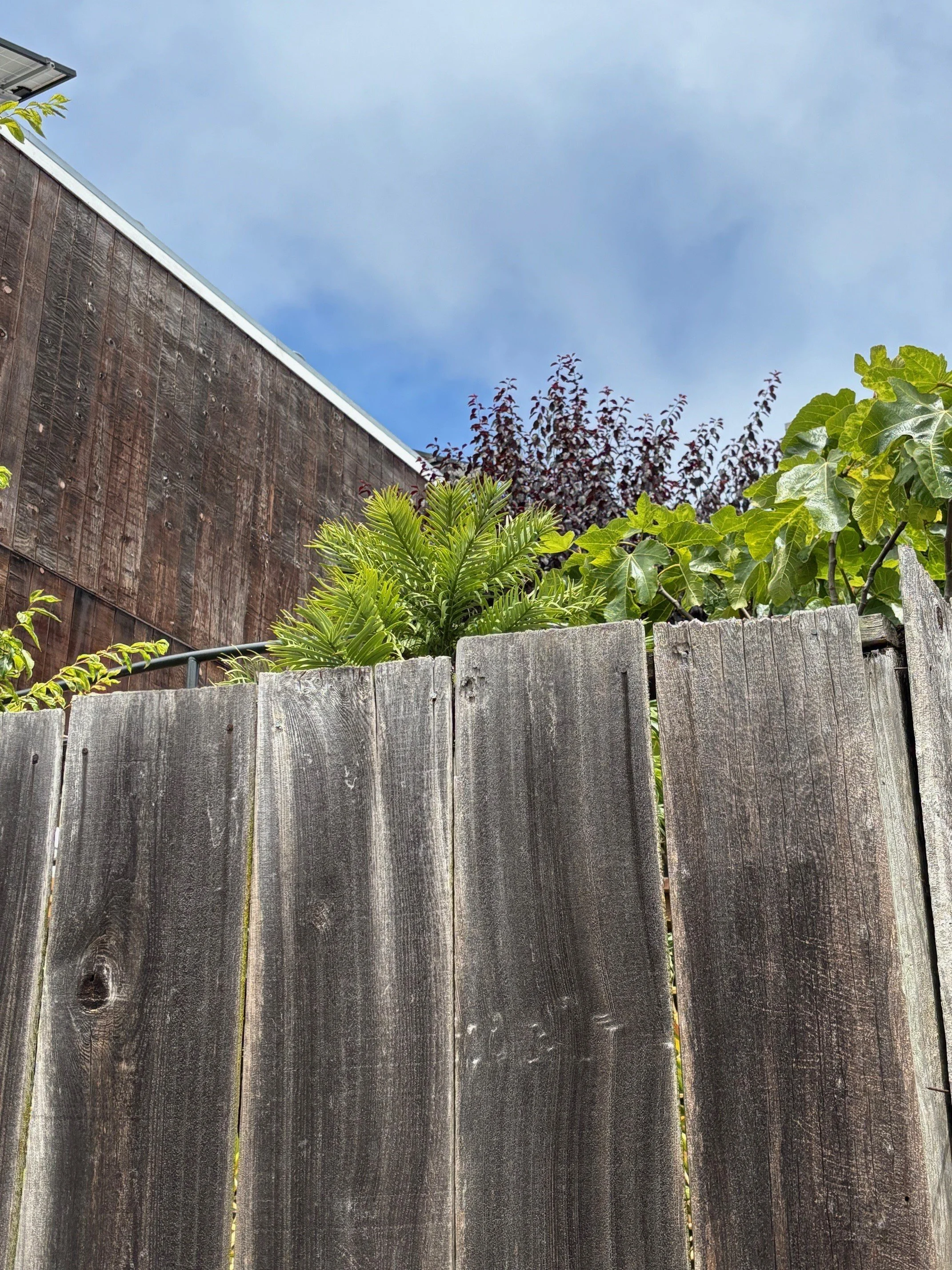Glen Park 2.0 Tour (Poppy Lane; Penny Lane; Ohlone Way) (7-13-25)
On a typical foggy, windy day in San Francisco, we returned to the charming Glen Park neighborhood to explore more of its trees—and its three unpaved alleys (two “lanes” and one “way”). As the fog cleared, captivating views opened to this hilly district and out of it to the south. Yet, the diversity of trees, the sometimes quirky architecture, and the delightful, albeit small, gardens along the way are what bring us back to Glen Park.
This tree walk begins on Sussex Street at the corner of Elk Street, and heads east along Sussex for three blocks to Conrad Street, where it heads north (uphill) for a short block to Poppy Lane. It turns into Poppy Lane and continues along this mostly unpaved “alley” to Diamond Street, where it turns right and heads downhill past Sussex to Penny Lane, another mostly unpaved alley. It heads southeast on Penny Lane to its end, where it becomes a set of neighborhood-created steps among California native plantings, ending at Surrey Street. It then heads northwest on Surrey, crossing Diamond again, and continuing along Surrey to Ohlone Way, the third unpaved alley on this walk. It heads up Ohlone to Sussex, then left on Sussex to Van Buren Street, and back downhill on Van Buren to Surrey. From there, it heads west on Surrey to its merge with Chenery Street, and on west on Chenery to the end of the walk at Elk. This walk is 1 ½ miles long.
Numbered trees are labeled with common and scientific names and country of origin, all written in white chalk on the sidewalk; accompanying numbers, in blue, run from 1 to 41. White arrows on the pavement provide directions whenever a turn is needed.
The street addresses provided below will help when the chalk has faded. Most of the trees are planted in pockets in the sidewalk pavement; a few are planted on private property between the sidewalk and the homes, and in rear gardens.
Sussex Street, Elk to Mizpah, south side
1. 395 Sussex Monterey pine (Pinus radiata), CA native: Año Nuevo, Monterey, Cambria, plus Cedros and Guadalupe islands, MX (most widely planted coniferous tree in the world, mostly for lumber)
2.395 Sussex Brazilian pepper tree (Schinus terebinthifolia), Brazil, Argentina, Paraguay
3. 385 Sussex Carob (Ceratonia siliqua), E Mediterranean Basin (there are several trees in this block; seed pods can be used to make a chocolate substitute—though not recommended for true chocolate lovers)
Sussex Street, Mizpah to Swiss Street, south side
4. 1 Mizpah English hawthorn (Crataegus laevigata), W & C Europe
5. 333 Sussex Cook pine (Araucaria columnaris), New Caledonia (similar to Norfolk Island pine, but this narrower, denser species always has a curve at the base of the trunk and a pronounced lean, usually toward the equator)
Guadalupe palm (Brahea edulis)
6. 333. Sussex Guadalupe palm (Brahea edulis), Guadalupe Island, Mexico (this palm is perfectly adapted to SF; it has been used in the median of Cesar Chavez Street in the Mission District)
Purple Robe hybrid locust (Robinia ‘Purple Robe’)
7. 301 Sussex Purple Robe hybrid locust (Robinia ‘Purple Robe’), hybrid of N American species (fragrant pink flowers in early summer)
8. 301 Sussex Two holly trees (Ilex species), Eurasia & N Africa (probably derived from the English holly, Ilex aquifolium)
Swiss Street at Sussex, west side
9. 116 Swiss Strawberry tree (Arbutus unedo) SW Europe to Ireland (a fine specimen; fruits are edible, though bland)
Sussex Street, Swiss to Conrad, south side
10a. 291 Sussex Primrose tree (Lagunaria patersonia), Norfolk and Lord Howe islands (soft pink flowers usually appear in summer)
10b. 291 Sussex Myoporum or ngaio in Māori (Myoporum laetum), New Zealand (this species is dying all over San Francisco, due to an insect pest called thrips that disfigures the new shoots; note that the leaves are poisonous)
11. 261 Sussex Flowering cherry (Prunus serrulata), Japan (watch for the pink flowers in April; note the point at which it was grafted unto an understock, about two feet above ground level)
12. 201 Sussex Marina strawberry tree (Arbutus ‘Marina’), hybrid of 3 Mediterranean species (first introduced in San Francisco)
13. 201 Sussex Hybrid tea tree (Leptospermum ‘Dark Shadows’), Australia
14. [not used]
**Cross Sussex carefully**
Sussex Street, west of Conrad, north side
15. 194 Sussex Hollywood juniper (Juniperus chinensis ‘Torulosa’ or ‘Kaizuka’), E Asia
Conrad Street, north of Sussex, west side
16. 120 Conrad Chinese elm (Ulmus parvifolia), China, Korea, Japan, and Vietnam (a particularly fine large specimen)
**Cross Conrad safely**
Conrad Street, north of Sussex, east side
17. 123 Conrad Sweetgum (Liquidambar styraciflua), E USA to Mexico & Central America (3 trees on Conrad and 1 at the corner of the residential property)
**Enter Poppy Lane; the lack of pavement prohibits labeling trees. The California Buckeye is about 200’ in, on the left, in the large rear garden of a house on Arbor Street.
California buckeye (Aesculus californica) [photo from June]
18. Poppy Lane California buckeye (Aesculus californica), California & Oregon; a San Francisco native tree! (this is the largest in the city; it’s just finished flowering, with fruits developing on many of the inflorescences)
**Along Poppy Lane, you’ll see a coast redwood, Canary Island date Palm, and avocado trees on the left, and purple hopseed bush, a struggling walnut, and a loquat in full fruit on the right
Diamond Street, Poppy Lane to Sussex, west side
Red-flowering gum (Corymbia ficifolia)
19. 2590 Diamond Red-flowering gum (Corymbia ficifolia), SW Australia (produces bright red, orange, or pink flowers in summer; among the best and showiest of trees in SF’s urban forest; we cannot understand why the city is no longer planting this amazing tree)
Diamond Street, at SW corner of Sussex
20. 2600 Diamond Meyer lemon (Citrus x meyeri), hybrid of mandarin and pomelo, both SE Asian species
**Cross the heavily traveled Diamond Street safely
Diamond Street, Sussex to Penny Lane, east side
21. 2607 Diamond Giant yucca (Yucca gigantea, formerly Y. elephantipes), Mexico & Central America
Blue spruce (Picea pungens)
22. 2607 Diamond Blue spruce (Picea pungens), Rocky Mountains (a particularly blue form)
23. 2609 Diamond African fern pine (Afrocarpus falcatus, formerly A. gracilior), E & S Africa
**Enter Penny Lane; the huge coast live oak is marked by a chalk label on bricks on the right side of the lane
Coast live oak (Quercus agrifolia)
24. Penny Lane Coast live oak (Quercus agrifolia), SF and CA native; Baja to Mendocino, always within 50 miles of the coast (this may be the largest specimen in the city—a truly glorious tree)
**Along Penny Lane, you’ll see fruit trees (mostly plums) on both sides, plus Italian buckthorn on the right, and a badly pruned incense cedar on the left. At the end of the lane, the stepped pathway leads down to Surrey Street through a planting of California natives, including fremontia and Matilija poppy.
** Cross Surrey Street carefully
Surrey Street, north of Penny Lane, west side
25. 53 Surrey Golden showers tree (Koelreuteria bipinnata), S China
26. 55 Surrey Water gum (Tristaniopsis laurina), E Australia (the northern tree of the pair, with smaller leaves; this tree grows in stream-side locations in the wild, hence the common name; SF’s most commonly planted street tree)
Elegant water gum (Tristaniopsis laurina ‘Elegant’), E Australia (the southern of the two trees; this selection of the water gum has longer, glossier leaves than the species)
27. 73 Surrey New Zealand Christmas tree, pōhutukawa in Māori (Metrosideros excelsa), New Zealand (many trees on throughout the neighborhood; this tree flowers most reliably in the summer months, which would be Christmas time in NZ, south of the equator; this specimen has been heavily pruned to allow sunlight through and thus is not flowering this year)
New Zealand Christmas tree, pōhutukawa in Māori (Metrosideros excelsa)
28. 99 Surrey Weeping bottlebrush (Callistemon viminalis), E Australia
**Cross Diamond Street carefully
Surrey Street, Diamond to Lippard, south side
29. 2700 Diamond Southern magnolia (Magnolia grandiflora), SE USA (3 trees along Diamond; many in the neighborhood)
30a. 2700 Diamond Red ironbark (Eucalyptus sideroxylon), E & SE Australia (3 trees along Surrey with dark, deeply fissured bark; red to pink flowers in spring)
Surrey Street, Lippard to Ohlone Way, south side
Queen palm (Syagrus romanzoffiana)
30b. 1 Lippard Queen palm (Syagrus romanzoffiana), S Brazil (2 trees on Surrey)
**Cross Surrey Street carefully, and turn right into Ohlone Way, the third unpaved alley on this walk; with little pavement, no labels have been chalked. As you walk up Ohlone Way, note the beautiful mural acknowledging the prior inhabitants of this land, the Ohlone people. You’ll see a small California buckeye and large specimens of Douglas-fir, Monterey cypress, and Monterey pine on the left; on the right, you’ll see plum and a bizarre English ivy “tree” growing atop the stump of an old cypress.
Sussex Street, Ohlone Way to Van Buren Street, south side
31. 135 Surrey Mayten (Maytenus boaria), Chile (2 young trees along Sussex, with gracefully pendant branches, resembling those of weeping willows)
Van Buren Street, Sussex to Surrey, east side
32. 3 Van Buren Lemon bottlebrush (Callistemon citrinus), E Australia (several trees on this block of Van Buren, all pruned into lollipop shapes)
33. 55 Van Buren Washington thorn (Crataegus phaenopyrum) E USA (note the last of the white flowers that will become colorful fruits in late fall; this specimen lacks the characteristic long thorns along its branches)
34. 75 Van Buren Swamp paperbark (Melaleuca ericifolia), SE Australia
**Cross Van Buren Street carefully
Van Buren Street at Sussex, NW corner
35. 70 Van Buren Douglas-fir (Pseudotsuga menziesii), West Coast & Rocky Mountains (tall conifer with needle-like leaves in the side yard; a CA native tree!)
Surrey Street, Van Buren to Swiss, north side
36. 320 Surrey Ruby Glow New Zealand tea tree (Leptospermum scoparium ‘Ruby Glow’), New Zealand (a small tree with tiny dark green leaves and small red flowers in winter and spring)
Pygmy date palm (Phoenix roebelenii)
37. 326 Surrey Pygmy date palm (Phoenix roebelenii), S China, Laos, Vietnam (a good use of this small palm)
38. 151 Swiss California buckeye (Aesculus californica ), California & Oregon; a San Francisco native tree! (this younger specimen on Surrey Street is still flowering)
Surrey Street, Swiss to Chenery, north side
Wollemi pine (Wollemia nobilis)
39. 100 Swiss Wollemi pine (Wollemia nobilis), E Australia (this rare tree, inside the fenced corner of the garden, has only grown a foot since we noted it on our Glen Park walk in late 2020; google it to read the intriguing story of the tree’s discovery in the mid-1990s)
40. 398 Surrey Canary Island pine (Pinus canariensis), Canary Islands (surprisingly uncommon in SF, these pines have noticeably long needles)
Canary Island pine (Pinus canariensis)
Chenery Street, Surrey to Elk, north side
41. 1006 Chenery Ginkgo (Ginkgo biloba), China (these distinctive deciduous trees are the last of an ancient lineage of Gymnosperms)
This walk ends at Elk, across the street from the Glen Park Recreation Center, and one block downhill from its start at Sussex Street.
Our regular commercial: This walking tour was organized by Mike Sullivan, author of The Trees of San Francisco and webmaster of www.sftrees.com; Jason Dewees, horticulturist at Flora Grubb Gardens and author of Designing with Palms; Richard Turner, retired editor of Pacific Horticulture magazine and Sairus Patel, soon to be author of Trees of Stanford. You can follow Mike and Jason on their tree-themed Instagram pages at @sftreeguy and @loulufan. Richard edited another great book on San Francisco trees: Elizabeth McClintock’s Trees of Golden Gate Park. If you’re a tree enthusiast, buy all four of these books!
